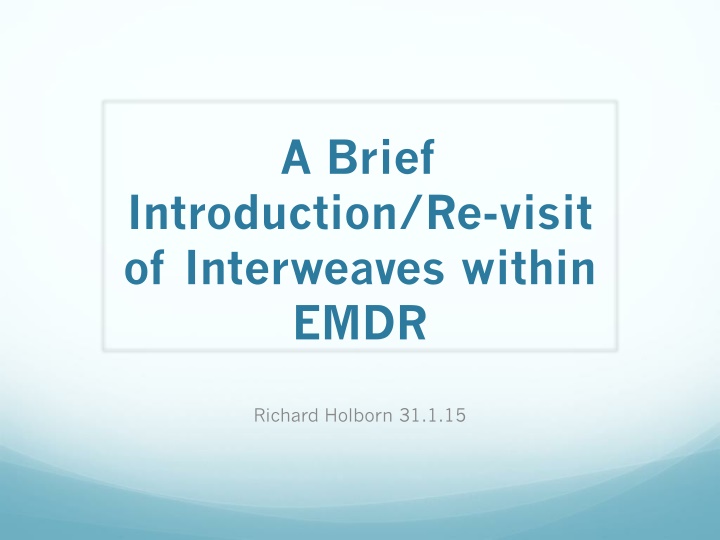
Enhancing EMDR Therapy: Interweaves and Cognitive Interventions
Learn about utilizing client-generated material and clinician-derived statements in EMDR therapy to access the Adaptive Information Processing system for continued reprocessing. Discover how Cognitive Interweaves can assist in addressing issues such as looping, running out of time, lack of generalization, insufficient information, and extreme emotional distress.
Download Presentation

Please find below an Image/Link to download the presentation.
The content on the website is provided AS IS for your information and personal use only. It may not be sold, licensed, or shared on other websites without obtaining consent from the author. If you encounter any issues during the download, it is possible that the publisher has removed the file from their server.
You are allowed to download the files provided on this website for personal or commercial use, subject to the condition that they are used lawfully. All files are the property of their respective owners.
The content on the website is provided AS IS for your information and personal use only. It may not be sold, licensed, or shared on other websites without obtaining consent from the author.
E N D
Presentation Transcript
A Brief Introduction/Re-visit of Interweaves within EMDR Richard Holborn 31.1.15
Definition Client-generated material + Clinician- derived/elicited Statements (Interweaves) = Access to AIP (reprocessing continues) Semantics Cognitive refers to the use of a statement, questioning, or direction by the clinician. The client may be asked to evoke, imagery, somatic feelings, emotions, thoughts or movement.
Definition EMDR clinicians are trained to stay out of the way as much as possible, since the therapist does not know what the best unconscious connections are that need to be made. When change has not occurred after consecutive sets of dual attention stimulation, then the clinician may use Cognitive Interweave and ask a question, or offer a statement for consideration, or suggestion of an action that is geared to elicit the next bit of information needed to continue the learning experience (Shapiro, 2007).
Used When: Looping Running out of time Lack of generalization Insufficient information Extreme Emotional Distress
Types of Issues Looping Although the clinician has used EMDR to unblock processing the client continues to remain at a high level of disturbance with the same negative thoughts, affect and imagery reoccurring.
Types of Issues Running out of Time Coming to the end of the session, and the client erupts into an abreaction or fails to process an abreaction sufficiently. (The target may be multifaceted more than one negative thought goes with image) More time is needed to continue processing.
Types of Issues Lack of Generalisation Processing does not generalise to other targets, despite the clients success at reaching a positive place in relation to a specific event.
Types of Issues Extreme Emotional Distress If the client is abreacting to the point of exhaustion, the clinician needs to intercede.
Types of Issues Insufficient Information The client is unable to process cognitively or behaviourally as they do not have the appropriate data.
Spontaneous Processing EMDR = Getting out of the way!! Once new information has been introduced the therapist should allow spontaneous processing to proceed.
Examples of Interweaves 1 New Information (Education Interweave) Stimulate Held Information I m Confused (Perspective shift Inquiry) What if your child did it (Perspective shift - Inquiry) Metaphor Analogy Socratic Questioning (i.e. You ask the client something to which they have the answer, and you know it but they don t yet. E.g. Who did the bad thing? )
Examples of Interweaves 2 Let s pretend . Child s perspective Add present time to adult thoughts Designate appropriate responsibility eg your uncle did this Change picture Resourcing Protective, Nurturing, Wise, (FMDS)
Examples of Interweaves 3 Date stamp it it s in the past. Now it can t hurt you any more I can choose now I am old enough to choose
General Guidelines Use only when the processing is stuck or to help in session closure (Shapiro) Use with imagination and routinely, esp with developmental trauma (Parnell) Offer the interweave, then move out of the way Don t interpret, inquire Use simple language, few words When processing a childhood memory use language and concepts a child would understand. (Laurel Parnell 2003)
Bridge Interweaves are basically helping the client bridge between; Past and present Memory networks Support - resource
You can employ some protectors
Thank you Cambridge Coordinator Richard Holborn 07799 47 45 41 info@cbtandemdr-cambridge.co.uk
